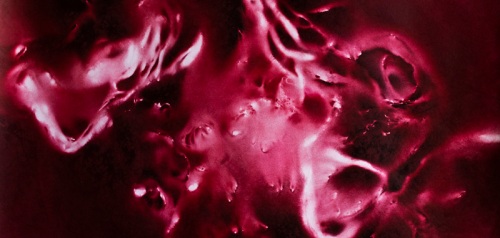Can You Take A Look At This? Nancy Baker Cahill’s fascinomas
by Tucker NeelCatalog Essay for fascinomas by Nancy Baker Cahill, The Pasadena Museum of California Art, 2012.
Nancy Baker Cahill’s recent paintings and videos of undulating, evocative, and sinewy forms against velvety expanses, compel one to ask, “Just what am I looking at?” A telescopic photo of a distant planet’s surface? Electron microscope renderings of epidermal abrasions enlarged to human-size? An ultrasound populated with disembodied bones and organs? While these Rorschach-like viewing experiences provide unbounded free associations, it’s their eerie familiarity that unravels, and complicates, how we see, and what we know. Cahill’s work explores how we are constituted by representations, how exploratory technologies, like microscopes, telescopes, and ultrasounds, inform understandings of ourselves, and the inner and outer worlds we inhabit.
The peculiar title of this exhibition, fascinomas, a medical term meaning an unusual case or diagnosis, addresses a problem of not knowing. Elusive and undefined, set outside of normal and knowable phenomena, the “unusual” maintains a proximal relationship to the unknown. Additionally, fascinoma springs from the etymological mixture of the prefix fascination, and suffix oma, a pathological reference to both morbidity and the growth of multiple tumors. This title, and its attendant allusions to an alien growth inhabiting, and perhaps killing, its host, places Cahill’s work in quite an unsettling position, something akin to the first explorations into the unseen depths of the human body.
While discussing early microscopic studies from the eighteenth century, art historian and artist Barbara Stafford notes that this new technology profoundly changed western perceptions of embodied existence: “Under the remorseless lens, a well-behaved anthropomorphic unity was pulverized into tiny and teeming minima. Not only were individuals overwhelmed by their corpuscles, but animals seemed to dissolve into the strangeness and indescribability of irregular polyps and multitentacled hydras”. Innovations in seeing, from the electron microscope to the Hubble Telescope, change human subjectivity, and in doing so shift previously coherent bodies into particles of an expanding infinite. This observation, and Stafford’s description of what it must have been like to look into a new interior world for the first time, a world brimming with fantastically descriptive language, intersects with Cahill’s arresting compositions.
Cahill’s conglomerations of attenuated cuts of and folds created by dense and light veils of pigment, are undeniably sumptuous and abject at the same time. We are drawn in by their subtle gradients, reminiscent of fabric or classical chiaroscuro. Yet buried within the forms is an analogous relation to eviscerated bodies and ghost-like fragments that haunt our own sense of mortality. This evidence of a presence marked by its absence is a direct result of the artist’s process.
Cahill creates her paintings with an airbrush, spraying layers of pigment over disparate objects, ranging from wires to dried kelp. She then removes these objects, leaving only the trace of their presence. This process charts its antecedence back to prehistoric instances of self-representation, the Upper Paleolithic cave paintings of France and Spain, with their walls of hands silhouetted by earthen pigments. One can only infer that such early paintings were meant to assert physical presence in the face of a precarious and perilous existence defined by danger and confusion. With their ghostly references, Cahill’s fascinomas signify a similar register of presence within absence. In her work we see a reflection of ourselves, how we wrestle with unsettling, unstable bodies within a world of endless unknowns.
©2024 Tucker Neel. All rights reserved.


